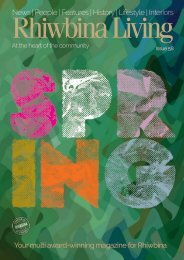Rhiwbina Living Issue 57
The 15 year anniversary issue of Rhiwbina Living, the award-winning magazine for Rhiwbina.
The 15 year anniversary issue of Rhiwbina Living, the award-winning magazine for Rhiwbina.
You also want an ePaper? Increase the reach of your titles
YUMPU automatically turns print PDFs into web optimized ePapers that Google loves.
sport<br />
the story of<br />
Welsh<br />
rugby<br />
Cardiff has been home to Welsh rugby for more than a century. This is the<br />
story from its roots in the late 1800s through to the modern game<br />
Sport divides and it unites. As far as<br />
Welsh culture goes, rugby is part of<br />
its very soul.<br />
Sport goes a long way back in<br />
Welsh history. In fact, the earliest<br />
documented source for a group<br />
ball game in Great Britain actually<br />
comes from Wales. Historia<br />
Brittonum (The History of the<br />
Britons), written in the ninth century,<br />
depicts group ball games after the<br />
Romans had left Britain. Cnapan<br />
was a Celtic medieval form of<br />
football around that time. The<br />
sport was one of the ball games<br />
traditionally played to celebrate<br />
Shrovetide and Eastertide within the<br />
British Isles.<br />
Rugby union is believed to have<br />
reached Wales during the 1850s,<br />
when the Reverend Professor<br />
Rowland Williams brought the<br />
game with him from Cambridge to<br />
St. David's College, Lampeter. The<br />
college fielded the first Welsh rugby<br />
team later that year. In September,<br />
1875, the South Wales Football<br />
Union was created ‘with the<br />
intention of playing matches with<br />
the principal clubs in the West of<br />
England and the neighbourhood –<br />
the rugby rules will be the adopted<br />
code.'<br />
Rugby union spread throughout<br />
the industrial south Wales valleys<br />
not long after, brought there by<br />
former college students who had<br />
played the game during their<br />
education away from home in<br />
England. At a time when soccer was<br />
flourishing in other parts of the UK,<br />
rugby union was taking Wales by<br />
storm. By 1892, there were 70 rugby<br />
clubs in south Wales alone, and by<br />
14<br />
1905, Cardiff had over 200 known<br />
teams.<br />
The Welsh Rugby Union was<br />
formed in 1881 to help facilitate the<br />
game more formally and out of the<br />
many clubs that were being formed,<br />
there rose some of the larger clubs<br />
throughout south Wales, such<br />
as Cardiff, Swansea, Llanelli, and<br />
Newport. Known as the 'Big Four';<br />
these clubs led the way in the<br />
game's development.<br />
It's been argued that the game's<br />
popularity could be down to the<br />
fact that rugby had originally<br />
been embraced by the betteroff<br />
students that attended the<br />
universities in the south and the<br />
west of the country. It would also<br />
explain why rugby never gained the<br />
same affection in the north of the<br />
country.<br />
South Wales was also a heavily<br />
industrialised part of the UK, and its<br />
workers were traditionally involved<br />
in more manual labour. This meant<br />
that they already had a physical<br />
advantage over other players who<br />
were perhaps in more white-collar<br />
work. Rugby was embraced by the<br />
working class as it gave them a<br />
sense of identity.<br />
At a more local level, many clubs<br />
were also being created from<br />
work places and social groups. As<br />
industrialisation spread and the<br />
towns and cities expanded, so too<br />
did the number of clubs popping up<br />
in the communities.<br />
Here in the capital, Cardiff Rugby<br />
Football Club was founded in 1876<br />
following at meeting at Swiss<br />
Hall, Queen St. The club was<br />
the amalgamation of two clubs,<br />
Glamorgan and Cardiff Wanderers,<br />
and their first competitive game<br />
took place against Newport at<br />
Wentloog Marshes in December of<br />
that year.<br />
The club's home games were<br />
initially played at Sophia Gardens<br />
but they subsequently relocated to<br />
Cardiff Arms Park, named after the<br />
nearby pub.<br />
Originally the Arms Park had a<br />
cricket ground to the north and a<br />
rugby union stadium to the south<br />
and the first spectator stands<br />
appeared at the ground during<br />
1881–1882. That same season also<br />
saw the first Welsh international<br />
match taking place, and the team<br />
included four players from Cardiff<br />
Rugby Football Club.<br />
It wouldn’t be until 1890, and their<br />
seventh attempt, that the Welsh<br />
national team achieved their overriding<br />
ambition and finally beat<br />
England. The team's first Triple<br />
Crown came in 1893 and was the<br />
launch pad for the first ‘Golden Era’,<br />
when Wales dominated the world<br />
game.<br />
They won Triple Crowns in 1902<br />
and 1905 and were also runners-up<br />
in the 1901, 1903 and 1904 Home<br />
Nations Championship. They won<br />
the title in 1906 and even beat the<br />
touring Australian team in 1908.<br />
In 1905, Wales played New<br />
Zealand in what has since become<br />
known as 'Gêm y Ganrif' or 'The<br />
Game of the Century'.<br />
The game was part of the New<br />
Zealand 'Originals' tour, where they<br />
played 35 games. By the time the<br />
All Blacks arrived in Wales, they<br />
hadn't conceded a single point

















